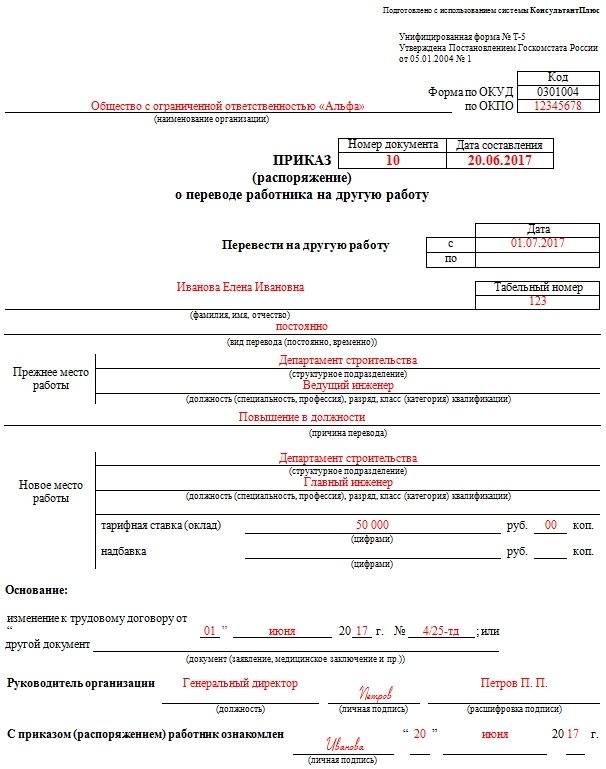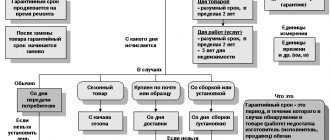What labor benefits are provided?
Legislation (Article No. 253, Russian Labor Code) limits the use of female labor in harmful, dangerous or underground work, and activities involving the transfer of heavy loads that are outside the permissible limits. But when an employee is pregnant, she has the right to demand a reduction in physical activity. The main thing is that there is no gender discrimination.
According to a medical report and at the request of the expectant mother, the employer is obliged to transfer her to a job that excludes harmful effects on the human body.
If new labor costs less, then payment for the result does not change - the woman receives the average salary of the position from which she was transferred due to pregnancy (Article No. 254, Russian Labor Code).
Until the transfer is completed, the woman is released from performing work duties while maintaining her salary.
In addition, it is prohibited (Article No. 259, Russian Labor Code):
- The use of labor force of pregnant women during night work shifts.
- Overtime employment.
- Business trips.
- Call on Saturday, Sunday and holidays.
How to apply
Registration of light work for a pregnant employee occurs according to the following algorithm:
- Submission of documents. An employer can transfer an employee to light work only upon presentation of a corresponding application and a medical certificate, which reflects the fact of pregnancy and the recommendations of the attending physician. A medical report is issued according to form No. 084/у. In addition to the need to transfer to simplified working conditions, it indicates factors that may be unfavorable for the expectant mother. The application is written in any form by hand and recorded in the internal documents register.
- Job offer. After considering the application, the employer must offer the employee a list of vacancies available at the enterprise that correspond to the classification of light labor and the employee’s qualifications. Since the salary at the new place cannot be less than at the previous job, the employer must indicate the difference with a bonus. For example, if the salary in the previous position was 30 thousand rubles, and in the new one - 24 thousand rubles, then the bonus will be 6 thousand rubles. According to labor laws, it is impossible to pay a lesser amount. After drawing up the proposal, the employee familiarizes herself with it against signature. Sample proposal:
- Obtaining consent. If a suitable vacancy has been found at the enterprise, the employee must give written consent to the transfer. Usually a corresponding statement is written. Some allow a simple signature on the job offer document.
- Drawing up an additional agreement. Drawing up an additional agreement is a mandatory condition for the transfer. It specifies new working conditions and return to the previous position, indicates the amount of wages and the validity period. The document is drawn up in two copies, one of which is attached to the employment contract, and the other remains with the employee. Sample agreement:

- Drawing up an order. The order is issued by the employer on the basis of a drawn up agreement. The document must indicate:
- deadline and reason for the transfer;
- new position;
- salary size;
- grounds for the procedure.

The employee reads the order against signature. A copy of the document can be provided upon request for further evidence of other work being performed. There is no need to make an entry in the work book about the transfer, since after returning from maternity leave the employee will return to her original duties.
The transfer period ends on the last day before the employee goes on maternity leave. This fact must be recorded by the employer in the appropriate order.
If a vacancy suitable for light work is not available at the enterprise, then the employer can introduce a new position specifically for a pregnant employee. After going on maternity leave, the position may be abolished at the discretion of management.
If there is no need for a new position, the employer releases the employee from her work duties with payment of a monthly salary.
Technical requirements for working as a pregnant woman
According to sanitary standards (Resolution No. 32 of the Sanitary-Epidemiological Committee), during pregnancy, workers are prohibited from working activities that entail an increase in physical, psychological, and overload of the body.
The expectant mother is prohibited from working:
- Forcing you to lift goods above your shoulders; from the floor surface; with muscle tension in the legs and abdominals; in a certain position of the body (squatting or kneeling, resting your stomach); with a mandatory tilt of the body at an angle of more than 15°.
- On machines with foot control.
- On conveyor technology with a preset movement rhythm.
- Leading to nervous and psycho-emotional loss of strength.
- Interacting with pathogens.
- Subject to infrared radiation above natural levels and at a temperature of working surfaces above 35°.
- Causing wet clothes and shoes, or taking place in drafts.
- With strong changes in atmospheric pressure.
- If there are no windows or sources of natural light in the place of work.
- Subject to continuous use of video display terminals and computers.
What is light labor during pregnancy?
The Labor Code does not contain a clear definition of “light work during pregnancy.” But the employer’s obligation, in the presence of a medical certificate, is legislated to reduce production standards or transfer the woman to easier work that excludes the influence of harmful production factors. At the same time, the average earnings of the worker should be retained.
Light work implies professional activity that requires less physical effort and does not have an adverse effect on the development of the fetus.
A pregnant woman should not perform work related to:
- lifting objects above the shoulders, from the floor;
- lifting weights;
- conveyor production process;
- nervous-emotional stress;
- pathogens (infections, fungi, parasites);
- poisons;
- infrared radiation;
- pressure changes;
- increased radiation, etc.
A woman can exercise her legal right to transfer to light work only after providing the employer with a medical report. Without this certificate, the employer is not obliged to change the working conditions.
Requirements for a woman’s place of work during her pregnancy
Legal norms (Resolution No. 32, adopted by the Sanitary and Epidemiological Committee of Russia) establish the necessary conditions for creating space for the future mother to work. It complies with the rules if:
- Allows you to perform actions in an unclamped mode and posture, makes it possible to change body positions at the request of the worker.
- It includes a swivel chair with adjustable backrest, which has holders for arms and head, and a lumbar protrusion. The tilt of the backrest can be adjusted depending on the time of pregnancy, the characteristics of the employee’s work and rest.
- Its design provides a footrest, the inclination and height of which can be adjusted at the discretion of the pregnant woman.
- The tabletop has a recess for the body, its corners are rounded, and the surface is matte.
The optimal temperature in the room, office, warehouse where a woman is located when performing her work activities is 23-25°C. Air humidity is 40-60%. Consecration is the maximum permissible, noise level is not higher than 60 decibels. There is no vibration or ultrasonic radiation. Atmospheric pressure corresponds to natural parameters.
Rights and obligations
The main responsibility of the employer is to transfer the pregnant employee to light work if she provides a medical report. If the employer cannot immediately provide a pregnant woman with suitable working conditions, and he needs time to resolve this issue, then she is released from work for this period, and the employer pays for all days the employee is absent from work.
A pregnant woman has the right to full annual paid leave. In this case, it does not matter at all how long the woman worked at the enterprise. Such leave is granted at the request of the employee either before maternity leave or immediately after it.

It is the employer's responsibility to comply with sanitary standards in the pregnant woman's workplace. In addition, the legislation guarantees its preservation for the woman in the position. The employer cannot terminate the employment relationship with her on his own initiative. If the term of the employment contract has come to an end, then, at the request of the employee, the employer is obliged to extend the agreement.
Registration of transfer to light working conditions
Legislatively (Article No. 253 of the Russian Labor Code) it is established that transfer to another position occurs at the request of the employee upon receipt of a medical report, which indicates the need to change the parameters for performing professional duties.
If an employee expresses a desire to change her job duties and confirms her status with medical documentation (it can be completed at the first visit to a gynecologist), the necessary work is selected. After this, the organization issues an order to transfer the woman to another job and set her a new salary, the minimum amount of which is equal to the average salary in her previous position.
Such a transfer is permitted at the will of the employer. To do this, the woman is sent an offer to move to another job. If she agrees to change her job function, a transfer order is issued.
After signing the internal order, an additional agreement to the work contract is drawn up. It is necessary to make changes to the employment contract according to the law (Article 72 of the Labor Code of Russia) if:
- There was a temporary change in the worker’s labor function.
- Her place of employment changes.
- Salaries change.
If situations arise when working conditions do not allow the expectant mother to be transferred immediately (there are no vacancies or the woman is not qualified), the employer removes her from work while maintaining the average salary. The suspension lasts until transfer becomes available.
“Easy” work for pregnant women. Problems of calculating average earnings
The female workers of our enterprise somehow became inspired by the call to raise the birth rate in the country and began to unanimously bring certificates from antenatal clinics recommending their transfer to “light labor” - Art. 254 Labor Code of the Russian Federation. We issue an appropriate order for a temporary transfer with instructions to maintain average earnings. Should average earnings in this case be calculated once, on the start date of the transfer? And if an employee went on sick leave during the period of temporary transfer, and then continued to work at “light work,” should the average earnings be recalculated? In other words, is a temporary transfer considered to be a single event for calculating average earnings, or is it interrupted by other events (sick leave, unpaid leave, time of referral for a medical examination, etc.)? Average earnings vary depending on the billing period. And if we take into account that expectant mothers spend several months, sometimes six months, in light work, the issue of calculating average earnings is of great concern to them.
Art. 254 Labor Code of the Russian Federation
It has been established that pregnant women, in accordance with a medical report and at their request, have production standards and service standards reduced, or these women
are transferred to another job
that excludes the impact of adverse production factors, while
maintaining the average earnings for their previous job
.
Average earnings in this case are calculated according to the rules established by the Regulations on the specifics of the procedure for calculating average wages, approved by Decree of the Government of the Russian Federation of December 24, 2007 No. 922
, which establishes the specifics of the procedure for calculating average wages (average earnings) for all cases of determining its size, provided for by the Labor Code of the Russian Federation.
The average earnings of an employee, regardless of his mode of work, are calculated based on the wages actually accrued to him and the time actually worked by him for the 12 calendar months preceding the period
, during which the employee retains his average salary.
In this case, a calendar month is considered to be the period from the 1st to the 30th (31st) day of the corresponding month inclusive (in February - to the 28th (29th) day inclusive).
That is, if, for example, you transfer a pregnant woman to “light work” from August 4, 2008, then the calculation period for calculating average earnings will be the period August 2007 - July 2008.
In this case, when calculating average earnings, it is excluded
time, as well as the amounts accrued during this time, if:
A)
the employee retained his average earnings in accordance with the legislation of the Russian Federation, with the exception of breaks for feeding the child provided for by the labor legislation of the Russian Federation;
b)
the employee received temporary disability benefits or maternity benefits;
V)
the employee did not work due to downtime due to the fault of the employer or for reasons beyond the control of the employer and employee;
G)
the employee did not participate in the strike, but due to this strike he was unable to perform his work;
d)
the employee was provided with additional paid days off to care for disabled children and people with disabilities since childhood;
e)
in other cases, the employee was released from work with full or partial retention of wages or without payment in accordance with the legislation of the Russian Federation.
If a pregnant woman goes on sick leave
, the average earnings, on the basis of which temporary disability benefits are calculated, are determined according to the rules of the Regulations on the specifics of the procedure for calculating benefits for temporary disability, pregnancy and childbirth for citizens subject to compulsory social insurance, approved by
Decree of the Government of the Russian Federation dated June 15, 2007 No. 375
.
In this case, benefits are calculated based on the average earnings of the insured person, calculated for the last 12 calendar months preceding the month of temporary disability.
.
At the same time, when determining the average earnings of the insured person for calculating benefits, benefits are excluded
the following periods, as well as amounts accrued for these periods:
A)
the period of preservation of the employee’s average earnings in accordance with the legislation of the Russian Federation;
b)
period of temporary disability, maternity leave, parental leave;
V)
period of downtime due to the fault of the employer or for reasons beyond the control of the employer and employee;
G)
the period during which the employee did not participate in the strike, but in connection with this strike was not able to perform his work;
d)
additional paid days off to care for disabled children;
e)
other periods when the employee was released from work with full or partial retention of wages or without payment in accordance with the legislation of the Russian Federation;
and)
the period during which the employee was provided with days of rest (time off) in connection with work beyond the normal working hours under the rotation method of organizing work and in other cases in accordance with the legislation of the Russian Federation.
An exception
to this rule is made for pregnant women.
According to clause 13 of Regulation No. 375, in the event of temporary disability in pregnant women or granting them maternity leave during the period of their performing lighter work
while maintaining the average earnings at the previous place of work, the average earnings for calculating benefits
include the average earnings
maintained during the transfer to such a job.
Thus, when determining the average earnings for paying sick leave for a pregnant woman, it is taken into account
average earnings maintained during the transfer of a woman to “light” work.
After returning from sick leave, the woman again receives a salary based on the maintained average earnings from her previous job.
In this case, the calculation period and average earnings are not
.
This is due to the fact that a pregnant woman retains the average earnings from her previous job
.
That is, average earnings (not for sick leave, but for wages) are calculated once
before transferring a pregnant woman to “light labor”.
The billing period includes 12 months of “previous” work.
Therefore, transferring to “light labor” to calculate average earnings is one event
(period) and other events do not interrupt this period.
Useful tips for switching to light work
If the working conditions of a pregnant woman include restrictions on working posture, drafts, wet clothes and shoes, changes in atmospheric pressure, low light, high temperature in the workplace (more than 35 degrees), or the need to walk more than 2 km per shift, she has the right to transfer to easier work.
The first step of a pregnant woman in this direction should be to contact her antenatal clinic with her attending physician, who, at her request, is obliged to issue her a medical certificate on the need to transfer to light work. After this, the employee provides the employer with a conclusion and a statement requesting the transfer.
It should be understood that there is no need to negotiate with the employer. Transferring a pregnant woman to light work in the presence of a medical certificate is not a gesture of goodwill, but the responsibility of the employer.
If the employer claims that light work is impossible at this workplace and invites the employee to resign of her own free will, his actions are illegal. According to the code, if an employer cannot provide a pregnant employee with adequate working conditions, she has the right to be absent from the workplace. In this case, the employer pays for all the time missed by the woman for this reason based on average earnings.

If the employer refuses to provide easier working conditions and does not want to pay for the absence of a pregnant woman from work, the employee can defend her rights in court. A woman has the right to refuse to perform work if it threatens her health, and she must notify the employer in writing. After this, you should go to court.
The reality is that an employer is unlikely to be delighted with an employee’s pregnancy, much less with the obligation to provide her with more comfortable working conditions. It will be even more difficult for him to get used to the idea that if he refuses to transfer a pregnant worker to light work, she has the right not to go to work, and the employer will have to pay her the average wage. The main thing in this situation is to know your rights. A medical report and the labor code will help a woman defend them. The court will always take her side, since preserving the health of the expectant mother and baby is a national task.
Author: Veronika Ivanova, especially for Mama66.ru








